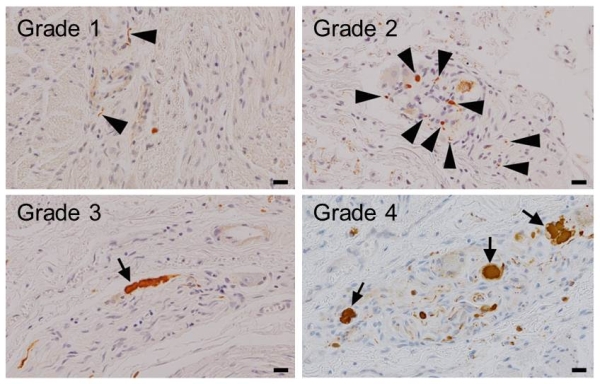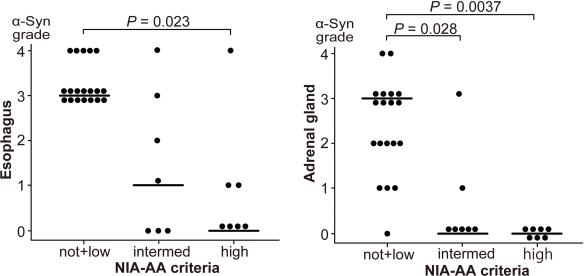Session Information
Date: Tuesday, June 21, 2016
Session Title: Parkinson's disease: Pathophysiology
Session Time: 12:30pm-2:00pm
Location: Exhibit Hall located in Hall B, Level 2
Objective: To examine whether the degree of α-synuclein (α-Syn) in the peripheral organs of patients with Lewy body disease (LBD: Parkinson’s disease, dementia with Lewy bodies [DLB]) is influenced by concomitant Alzheimer’s disease (AD) pathology.
Background: LBD is characterized by the pathologic α-Syn and is often complicated by AD. The relationship between the comorbid AD pathology and the degree of α-Syn in the peripheral organs in LBD has received less attention than that in the brain.
Methods: Of 363 consecutive full autopsies of subjects in our Brain Bank performed between Oct 2008 and Jun 2015, the organs of 33 subjects with autopsy-confirmed LBD were immunohistochemically analyzed with a monoclonal antibody against phosphorylated α-Syn (pSyn#64). Neuropathological diagnosis was based on the third report of the DLB Consortium for LBD and the National Institute on Aging-Alzheimer’s Association (NIA-AA) criteria for AD. The degree of α-Syn in the esophagus and adrenal gland was semi-quantitatively classified into 5 grades  as follows: Grade 0, absent; Grade 1, 1-3 thin neurites (arrowheads) under 10 μm in diameter; Grade 2, ≥ 4 thin neurites, but lack of neuronal cytoplasmic inclusions (NCIs) and swollen neurites; Grade 3, 1-2 NCIs or swollen neurites (arrow); Grade 4, ≥ 3 NCIs or swollen neurites. The presence of constipation was determined from medical records. For multiple comparisons, the Kruskal-Wallis H-test followed by the Mann-Whitney U-test with Bonferroni correction was used. The Fisher’s test was used to assess the difference between paired proportions.
as follows: Grade 0, absent; Grade 1, 1-3 thin neurites (arrowheads) under 10 μm in diameter; Grade 2, ≥ 4 thin neurites, but lack of neuronal cytoplasmic inclusions (NCIs) and swollen neurites; Grade 3, 1-2 NCIs or swollen neurites (arrow); Grade 4, ≥ 3 NCIs or swollen neurites. The presence of constipation was determined from medical records. For multiple comparisons, the Kruskal-Wallis H-test followed by the Mann-Whitney U-test with Bonferroni correction was used. The Fisher’s test was used to assess the difference between paired proportions.
Results: The LBD subjects with “high” likelihood of AD pathology in NIA-AA criteria showed less α-Syn in the esophagus and adrenal gland than LBD subjects with “not+low” likelihood of AD (P = 0.023 and 0.0037, respectively  ). Constipation was significantly more prevalent in the subjects with higher grade “3+4” of α-Syn in the esophagus than those with lower grade “0+1+2” of α-Syn in the esophagus (P < 0.001). Constipation was significantly less prevalent in LBD subjects with “intermediate+high” likelihood of AD than those with “not+low” likelihood of AD (P < 0.001).
). Constipation was significantly more prevalent in the subjects with higher grade “3+4” of α-Syn in the esophagus than those with lower grade “0+1+2” of α-Syn in the esophagus (P < 0.001). Constipation was significantly less prevalent in LBD subjects with “intermediate+high” likelihood of AD than those with “not+low” likelihood of AD (P < 0.001).
Conclusions: The degree of α-Syn in the peripheral organs declines as the severity of AD pathology increases in the subjects with LBD. Although LBD subjects usually suffer from constipation, lacking constipation may be related to less α-Syn in the gut and underlying AD pathology.
To cite this abstract in AMA style:
H. Sumikura, J. Fujigasaki, Y. Nakano, A. Uchino, Y. Saito, H. Mochizuki, S. Murayama. α-synuclein in peripheral organs decreases in Lewy body disease complicated by Alzheimer’s disease [abstract]. Mov Disord. 2016; 31 (suppl 2). https://www.mdsabstracts.org/abstract/synuclein-in-peripheral-organs-decreases-in-lewy-body-disease-complicated-by-alzheimers-disease/. Accessed December 16, 2025.« Back to 2016 International Congress
MDS Abstracts - https://www.mdsabstracts.org/abstract/synuclein-in-peripheral-organs-decreases-in-lewy-body-disease-complicated-by-alzheimers-disease/
